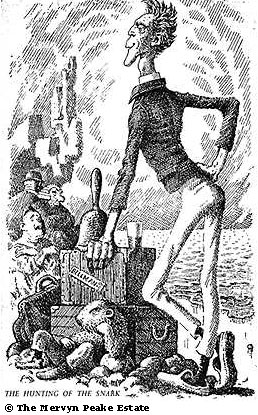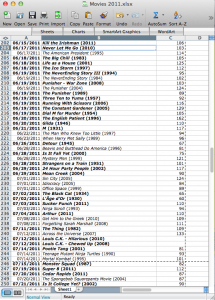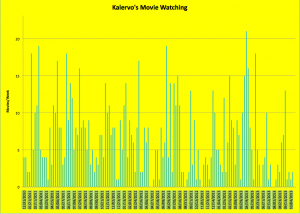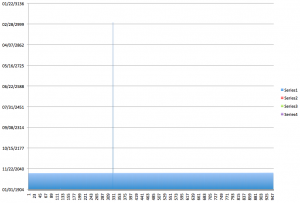Order on Order (the story, the map, the disturbing landscape of…)
(bootcamp: the markdown)
.
The map in Lewis Carol’s Hunting of the Snark is a blank. Yet they make it to the island (what is an island defined by a blank map?). Order in the Hunting of the Snark is a series of absurdities-as-rules brought about by the author, including the narrative itself which could be summarized as follows:
THE LANDING > THE VANISHING
Its sad this, but less sad than it would be without the humour of order, without lyric and narrative jest layered like the smooth membrane of a page (as a map of time) over nothingness and the inevitable (if a narrative ‘inevitable’ is not already a map of time). This “agony in eight fits” begins when the omniscient (or so the crew is lead to believe) Bellman lands his crew with care,
“Just the place for a Snark!” the Bellman cried, as he landed his crew with care; Supporting each man on the top of the tide by a finger entwined in his hair.
If we keep to the story, if we abide by the rules of this map, we will be safe, held gently above the abyss. We will be carried along with pleasure… to the end, far off in the future. It is a story for children.
My own copy of this epic quest (I think it was one of the first books I owned—it is definitely the book I have owned for the longest) is one illustrated by Mervyn Peake. I only discover today as I format this probe that the original (1884) illustrations were by Henry Holiday. We can compare the Bellman (Holiday -left; Peake-right):


Funny though, I thought the Bellman supported his people with a finger entwined in his own hair, not their hair! Needless to say I see the Holiday illustrations as latecomers, as wrong. The Peake illustrations were always ominous and disturbing for me. I owned this book before I could read. So the form of this book with its strange typography filled with quotation marks always fascinated me. Likewise, the two-handed mathematical calculations of the Butcher demonstrating how many times he said something while the Beaver looks on, deeply worried, were also a strange field of glyphs for me. This little book still resonates with this disturbing encounter with (incomprehensible) language and numbers. It is a feeling I still often feel when an external narrative of order or methodology presents itself.
On the cover of my copy of the hunting the title and author’s name is underlined in brown crayon (by me, I know). Inside the cover is the inscription ottwo.5 in the same brown crayon. Beside it, in my mother’s handwriting is my name and address. ottwo, if you can’t guess, is Ottawa. I do remember getting my mother to complete the inscription which marked my ownership of this little book. After I learned to read I was embarassed by the clumsy writing and mis-spelling. I’ve gotten over this.
Back to the map. I have spent most of my life without a tangible reference for the geography of the Hunting of the Snark. Fortunately, now I see images of the original 1884 illustrations which include Holiday’s very precise rendition of the map. It is a blank, a perfect blank, but one (to my dismay) framed by references to what lies haphazardly beyond this frame.

]]>
The post Boot Camp: My Sad Life, Quantified appeared first on &.
]]>Journalling takes us back some years to the emergence of the middle class, mercantiles documenting many of the more banal aspects of their day-to-day lives in keeping with the running of their households and businesses. Daniel Defoe elevated record-keeping to an art form with Robinson Crusoe, most of which is taken up in detailing inventories and explorations across the shipwrecked protagonist’s dessert island. At a certain point, personal archiving became the exclusive realm of those with the time and resources of a cosmopolitan upper class who knew they were already going to leave a mark on history: take for instance presidential libraries or Margaret Atwood’s meticulous preservation of everything she writes from manuscript drafts to correspondence to grocery lists. Today, everything is digital and automated, and the middle class is right back to journalling without even realizing it by way of life-hacking: we let apps and websites keep track of what we do in an effort to learn more about our own habits. Which brings me to me. Over the last few years, I’ve begun keeping track without understanding why. Earlier this year, my mother-in-law gave me a Fitbit One activity tracker that monitors my exertions, calorie intake and expenditure, and sleep quality; and since 2010 I’ve been using Shelfari to keep track of what I read (it used to be a lot of novels, and then I went back to graduate school and almost exclusively became theory and comics). But all of this is trumped by my great shame: for the past three years, I’ve been keeping a spreadsheet of all the movies I watch. And it’s a lot. (fig. 1)
(figure 1: a random sample of my movie watching habits. I could tell you a hundred things about how these records relate to each other)
Before I explain how this spreadsheet works, full disclosure: in the past 1,027 days (January 1st, 2011 to today), I’ve watched 951 movies. That’s not too embarrassing: it averages out to 1.079 movies a day 7.559 movies a week. Respectable, if only it was actually one movie a day and seven and a half movies a week. Instead, it ends up being zero movies some weeks and more than 20 other weeks. But I’m getting ahead of myself. The spreadsheet is simple: column A is the date I view a film, column B is the title and release year of the film, and column C is the film’s running time. A bold entry indicates if it was my first time seeing the film in question. In 2012, I start keeping a fourth column, D, that I mark if I saw the movie in theatres (in 2012 I saw 312 movies, only 12 of which were in theatres, and I didn’t start using Netflix until this summer, so I’m a dirty pirate). This chart alone is interesting to me, in that I can observe a thought process running throughout it: one actor or director leads to another, or seeing a particular genre film will remind of something along the same lines I haven’t seen in years. It’s a bit like Moretti’s flow of novel genre: some subtypes subtend toward others, which eventually supplant them.
It wasn’t until a few days ago that I realized I should be writing my boot camp exercise about my own movie-watching habits, so I scrambled to learn enough about Excel to turn this spreadsheet into a histogram (fig. 2):
(figure 2: My movies per week for over 140 weeks. For a larger image click this: Kalervo’s Movie Watching)
It’s amazing what this chart tells me. I can connect huge spikes to times when I was doing a lot of writing or non-lit review research tasks (I like the background noise and must have ground through half of Hitchcock’s library writing a draft of my MA project in March of 2012), and I can connect drops to times in my life where I was otherwise occupied (the two biggest gaps are in late April of 2012, right after I finished my Master’s degree, and July/August of 2013, the month I got married). I can actually track major events, turning points, and trials in my life, just from the amount of movies I watched.
This was not easy. If the main point of these exercises is learn to do new forms of research, then the process of creating this histogram tells me a lot about how I should be doing things different in keeping my records, making my spreadsheet. For starters, Excel did not like the date format I was using. Getting around that took some time, and the first time I tried to put everything into a chart it came out a horrid mess (fig. 3):
(figure 3: my first attempt at a chart. Note the date range: 1904-3136. What?)
Secondly, bolding entries for new movies is useless in creating a visualization: Excel doesn’t recognize bold. I should have had things separated out a whole lot more: One column for title, another for year, another for if it was my first viewing of the title. If I had had just two extra columns, virtually no extra effort in the moment I create the record (as I was already adding year and newness, just not in different columns), I could have known a host of new things, from the time of year (if any) I tend to see new movies to what release years my viewing habits tend to favour. I can go back now and do that, but what would have been cake at the time is extremely tedious to do all at once now. And if I’d been more diligent in recording running times, I could have visualized total minutes spent watching movies as well (though frankly I’m relieved not to be able to show you that). It also wouldn’t hurt me to jazz the infographic up a bit. I’m far from Nicholas Felton’s annual Feltron reports in my aesthetic (see featured image), and while up until now I’d always appreciated him as a graphic designer, I imagine he must have quite a bit of programming know-how too in order to predict the kind of things his programs would expect from him in terms of valid input. The demystification of the process is also remystifying: while I know now bolding entries was not helpful, I’m not sure the ideal value to put into my new column for newness.
In any event, I’m actually extremely impressed by how useful this record can be about telling you about me. In quantifying myself and my habits, I also quantify a corpus of texts according to my own biography. And while I hold no illusions that I’ll be interesting for future generations of scholars, it gives an organizing principle to my every action. Everything we do when we journal and archive ourselves is imbued with extra meaning. How that meaning values for others is less important than the intrinsic value we can see for ourselves in our own lives lived.
The post Boot Camp: My Sad Life, Quantified appeared first on &.
]]>The post Text to Image appeared first on &.
]]>With the help of a friend I wrote a program in C# that converts text files into images. I’m not a programmer so please forgive me if I haven’t got the lingo quite right. The code was compiled in Unity and the output was converted from a targa file to a PNG in Gimp (so that I could post it here). Below is a description of the process, including some of the things that occurred to me as I reflected on what I had done. Included in the description is the actual code, and an image of the code used to produce that image.
This is an image of the text you’re about to read:
HexASCII: On Learning to Code
You want to write a program that transforms digital text into image. It’s a problem of translation, of re-visualization. You ask a friend for help. He provides you with a map.
This is the map:
1. open txt file
2. open file that I create
(use tga file format, header + raw data, can use gimp to convert)
3. write tga header to file I created
4. for every char in txt file write that char after the header
5. close files
On a raft of language, pulled by strange currents, you encounter swarms of code, slippery as fish, blooming on the surface of a sea of images and text. The problem is somewhere below you, an oily shadow. You don’t even know what you’re hunting for, not really, and it’s easy to lose your bearings when the whole world seems to shift under your weight. It’s a matter of focus: a tuning of the eyeballs, a flickering of the ears. Like radio stations, recognizable sounds fade in and out of static. Each channel, each layer of abstraction, is like a pane of glass, more or less transparent, more or less cloudy, more or less warped. Each time you manage to break through a pane, you experience a heady rush of oxygen, a flush which leaves you giggling and wheeling, as if you’ve just stepped off a merry-go-round. You feel five years old again, triumphant, emboldened…until you run, face first, into another pane of glass.
Half of you is hunting and half of you is simply being swept away, pulled along by the swarm, by your rumbling belly, by the hands of your friend. You’ve been setting fires along the way. You’ll have to come back for those later. You’ve also been building, and breaking, and re-building. Gates and funnels and tiny machines of sapphire, bubblegum, and tar, that fetch and split and tear and mend and engulf whole strings of commas and bytes.
It’s with these little machines, these hooks and lines, that you finally catch your problem, your enigma:
using UnityEngine;
using System.Collections;
using System;
using System.IO;
namespace FileIOApplication
{
class TargaConverter
{
public static void DoIt()
{
{
BinaryWriter bw;
BinaryReader br;
FileInfo info;
//get text file length
info = new FileInfo(“/Users/carolyn/Documents/HUMA888/text_to_image.txt”);
double size = info.Length;
short width = (short)Math.Round(Math.Sqrt(size/3),0);
short height = width;
//create the file
try
{
bw = new BinaryWriter(new FileStream(“/Users/carolyn/Documents/HUMA888/image_from_text.tga”,
FileMode.Create));
}
catch (IOException e)
{
Console.WriteLine(e.Message + “\n Cannot create file.”);
return;
}
//writing into the file
try
{
byte[] buffer = {
(byte)0,
(byte)0,
(byte)2,
(byte)0,
(byte)0,
(byte)0,
(byte)0,
(byte)0,
(byte)0,
(byte)0,
(byte)0,
(byte)0,
(byte)(width & 0x00FF),
(byte)((width & 0xFF00) / 256),
(byte)(height & 0x00FF),
(byte)((height & 0xFF00) / 256),
(byte)24,
(byte)0
} ;
bw.Write(buffer);
}
catch (IOException e)
{
Console.WriteLine(e.Message + “\n Cannot write to file.”);
return;
}
//reading from the file
try
{
br = new BinaryReader(new FileStream(“/Users/carolyn/Documents/HUMA888/text_to_image.txt”,
FileMode.Open));
}
catch (IOException e)
{
Console.WriteLine(e.Message + “\n Cannot open file.”);
return;
}
try
{
while(true)
{
bw.Write(br.ReadByte());
}
}
catch (EndOfStreamException e)
{
Console.WriteLine(e.Message + “\n Reached end of file.”);
return;
}
catch (IOException e)
{
Console.WriteLine(e.Message + “\n Error”);
}
br.Close();
bw.Close();
}
}
}
}
public class TexttoImage : MonoBehaviour {
// Use this for initialization
void Start () {
FileIOApplication.TargaConverter.DoIt();
}
// Update is called once per frame
void Update () {
}
}

It’s with these that you crystallize its form, pry open its jaws, and peel back its skin. And while you’re eager to plunge your fingers into its slick, silvery body, to pluck out each organ like a green grape, and unravel its veins, you’re also afraid. The interior is bigger than it first appeared. The chambers are multiple, cavernous, and filled with echoes, and you are suddenly aware of just how little you know. What will you create with this shell of an enigma? A house of mirrors? A carpet of noise? A mosaic? What you want is explosives, an open wound, a photograph that makes it all worthwhile. No more plastic, no more smug remarks hanging from the ceiling like chintzy chandeliers, no more hollow words soaked in alcohol and wrapped in leaves of smoke, no more pretentious bullshit overflowing porcelain bowls, no more howling girls and deaf ears (especially that), no more humans, no more objects, only process, only change.
For a moment you place the enigma over your head, like a mask, and try to explain.
All things are in motion. Stasis is an illusion concocted by humans who feel sick to their stomach when they try to imagine otherwise; ideology is the vomit. We are swimming in our own vomit. We think we prefer simple lies to complex truth when in reality, we swap simple truth for complex lies that rattle with contradictions. Of course preference has nothing to do with it; agency and reality are convenient fictions, tools in the hands of the powerful and the influential. Tools to brand us as heroes or criminals, tools to funnel us into our respective institutions, tools to carve “you are free” on the insides of our skulls. What is freedom really? Freedom to crawl out of the mire, freedom to stop saying yes sir, no sir, freedom to play, freedom to work as we will for what we will, freedom to overthrow.
All this with a little program, you say? All this with a simple problem of translation, of re-visualization, of indexical relations? Of course not. This is nothing but a fragment, a small chunk of plaster torn from the wall. But even this is beginning to expose the wire-laced ribs of the rules and devices in which we’ve placed so much of our trust.
What happens when we take a familiar face, and turn it inside out? The point isn’t to see an inverted face, the point is to find out what makes it tick, who made it, and why. The point is to see everything as arbitrary, artificial, constructed. The point is to tear it down and remake it in our own image. Fuck Mount Rushmore, fuck Steve Jobs, fuck Microsoft and its proprietary software. We are a direct threat to all of that, but it’s only when we pick up the tools, only when we turn privilege against itself and peel back the skin, only when we learn to dig our fingernails into the oil-drenched belly of the beast, only then do we feel, in a cold sweat, the flesh, blood, and bone beneath this shining world of circuitry and digits.
Learning to code is no more revolutionary than learning to read and write.
Learning to code is no less revolutionary than learning to read and write.
The post Text to Image appeared first on &.
]]>


